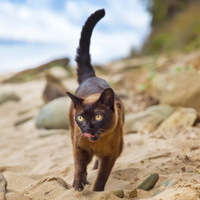 |
American Burmese |
|
TranslationFrancis Vandersteen |
||
OriginThe American Burmese is a cat breed originating in Burma and developed in the United States from the 1930s onwards. |
| This medium-sized cat is characterized by its sepia-toned coat. It differs from its English counterpart mainly by its face and round eyes. |
Standard |
| The American Burmese is the only Burmese recognized by the American Cat Fanciers Association (ACFA) and The International Cat Association (TICA). The Livre officiel des origines félines (LOOF) and the Cat Fancier Association (CFA) distinguish between the two types; note that the CFA refers to the American Burmese as the "Burmese" and the English Burmese as the "European Burmese". |
A brief historical overview |
| The Tamra Meow or Book of Cat Poems is a richly illustrated Thai collection of verse written between 1350 and 1767, describing seventeen different cats, some lucky and some not. The manuscript lists and poetically describes the breeds of cat in existence at the time, including a description of the Burmese. It is possible that Burmeses competed in England in the 19th century as Siamese. In 1930, an American sailor brought a Burmese cat back to San Francisco: Wong-Mau, whose hazel-colored coat showed slight variations in color intensity, stronger at the extremities (legs, tail, head) but without the spiked pattern. Wong-Mau was purchased by Dr. Joseph Thomson. Another version of the story holds that Joseph Thomson brought Wong-Mau directly from Burma. The doctor made several crosses with cats of Thai origin, notably a sealpoint Siamese, to reproduce Wong-Mau's coat. The Cat Fancier Association (CFA) recognized the breed in 1936. The first Burmeses were imported to the UK in the early 1950s and recognized by the Governing Council of the Cat Fancy (GCCF) in 1952. At the end of the 1950s, the Siamese breeding program came to a halt, and American Burmese breeders decided that their breed could only be bred in one color: seal sepia, also known as sable in France, i.e. genetically sepia black. In the 1970s, the American Burmese type became more pronounced: the face became rounder, as did the eyes and forehead, and the body became cobby. Until 1984, blue, chocolate and lilac Burmeses were listed in a separate breed by the CFA, the Mandalays, while the TICA recognized them as Burmeses. The differences between the American-type Burmese and the English-type Burmese became too great, and two breeds were now recognized: the English Burmese and the American Burmese. |
Behavior / characteristics |
| Christiane Sacase describes the Burmese as exuberant and athletic, adapting to life in an apartment but preferring to live outdoors where they are good hunters. He is loyal and affectionate with his master. Its voice is reminiscent of the Siamese. Dr. Bruce Fogle considers them to be very attached to their master, even clingy. |
Head |
||
Cranial region |
||
Head |
The head is round, with no flat areas. | |
Stop |
Very pronounced stop. | |
Facial region |
||
Forehead |
The forehead is rounded. | |
Nose |
The nose is rounded. | |
Muzzle |
Short muzzle. | |
Cheeks |
The cheeks are rounded. | |
Eyes |
Round, well-spaced, but not protruding, yellow eyes (green and blue are not accepted). | |
Ears |
Medium-sized, rounded at the tip, set wide apart and tilted forward. The American Burmese must not resemble an Exotic Shorthair. | |
Neck |
| The neck is small to medium-sized. |
Body |
||
Generality |
The American Burmese is muscular and surprisingly heavy for its size, so much so that it is said to be like "brick wrapped in silk". Strong bones. | |
Tail |
| The tail is shorter than that of the English Burmese. |
Limbs |
Forequarters |
||
Shoulders |
Slightly rounded shoulders and hips. | |
Hindquarters |
Coat |
||
Coat and texture |
The coat is short and glossy, close to the body. The pattern is sepia, i.e. solid color with subtle shading on legs, head and tail. Accepted colors are black (seal sepia or sable), blue, chocolate (champagne) and lilac (platinum). | |
Size and weight |
||
Height at withers |
Male height at withers: between 22 and 25 cm. Female height at withers: between 22 and 25 cm. |
|
Weight |
Average adult male weight: between 3.5 and 7 kg. Average adult female weight: between 3.5 and 7 kg. |
|
Penalties |
 Flat forehead. Flat forehead. Fine bone structure. Fine bone structure. Whip-like tail. Whip-like tail. Coarse texture or open coat. Coarse texture or open coat. |
Refusal of any title |
 White patches. White patches. Green eyes. Green eyes. Type too close to Exotic Shorthair. Type too close to Exotic Shorthair. Protruding eyes or chin. Protruding eyes or chin. General faults and defects eliminatory in show. General faults and defects eliminatory in show. |
Authorized marriages |
| Only matings with sepia-black American Burmeses are authorized by LOOF. The Cat Fanciers' Association and the Australian Cat Federation also authorize matings with black American Shorthairs. TICA prohibits all outcrosses. |






 English (United Kingdom)
English (United Kingdom)